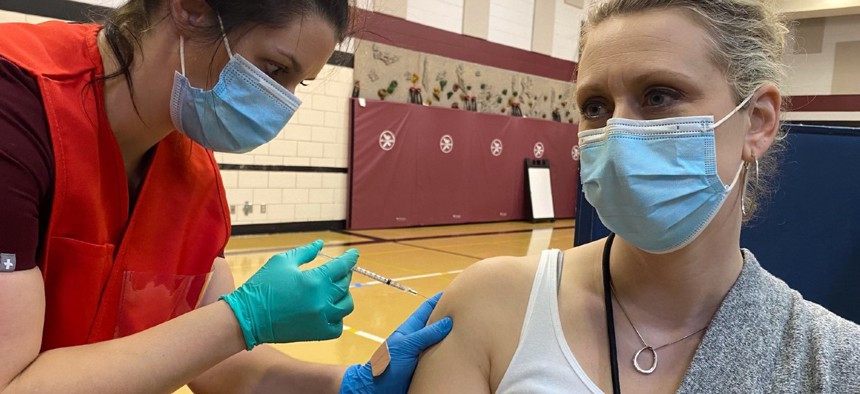
Family Nurse Practitioner Andrea Athmann-Luksik, the first IHS employee to receive a COVID-19 vaccine, receives her second vaccine dose at the Cass Lake Hospital in Minnesota to complete the vaccine series, on January 5, 2021. Indian Health Service file photo
A Watchdog Dings the Indian Health Service’s Early COVID-19 Vaccine Rollout
The agency described the steps it has taken over the months to rectify these issues.
A federal watchdog dinged the Indian Health Service’s early execution of its COVID-19 vaccine plan for Tribal health programs, which serve some of the communities hit the hardest by the coronavirus pandemic.
The Health and Human Services Department Office of Inspector General released a report last week on the Indian Health Service’s implementation of their Memorandum of Agreement with the Centers for Disease Control and Prevention (which it entered into in November 2020) and its plan, issued around the same time, outlining how it would carry out the delivery and administration of vaccines.
“IHS did not fulfill all of the provisions outlined in the MOA and its Vaccine Plan to help ensure that the vaccination program was implemented appropriately at Tribal [health] programs,” said the report released last week, which covers the time period of mid-December 2020 to late February 2021. “Though Tribal programs were permitted to prioritize vaccines to protect their tribal members, IHS, as a jurisdiction, had responsibilities outlined in [both] to ensure that the vaccination program was implemented appropriately.”
Tribal health programs authorized under the 1975 Indian Self-Determination and Education Assistance Act let Native American Tribes and Tribal organizations provide health care programs and services that IHS would have otherwise offered. These are one of the three IHS programs and provide care to most IHS beneficiaries, so they were expected to carry out most of the vaccinations, the report noted. That is what the IG looked at exclusively.
Specifically, IHS didn’t always provide Tribal programs the resources and help to make sure that they met reporting requirements on vaccine administration, used proper billing methods and entered allowable dual-program agreements with states and IHS, the IG office found. “Because of these deficiencies, the administration of the COVID-19 vaccine program was adversely impacted.”
The IG office found that the “total doses administered by Tribal programs could not always be verified for the applicable time period, and doses administered were not always reported in a timely manner; some patients were directly billed for administration of the COVID-19 vaccine; and some Tribal programs could have received vaccine doses from their state (in addition to the doses they received from IHS allocation).”
Elizabeth Fowler, then-acting director of IHS, wrote in a response to the IG office that she agreed with their four recommendations and summarized the actions the agency had taken since the IG’s review time period.
“While the IHS has limited options to enforce Tribal compliance with vaccine program requirements, the IHS agrees with the importance and need for Tribes to comply with vaccine program requirements and to employ effective reconciliation tools and processes,” Fowler said. Since IHS received and reviewed the draft report, Roselyn Tso was sworn in as the IHS director.
American Indians and Alaskan Natives had disproportionate COVID-19 infection rates and deaths and were affected in other adverse ways by the pandemic. Inequities related to food, water, housing, health outcomes and environmental conditions were exacerbated by the pandemic, said Lindsey Schneider, Joshua Sbicca and Stephane Malin, associate professors at Colorado State University, in June 2020.
They wrote: “As we see it, Native American communities face structural and historical obstacles related to settler colonial legacies that make it hard for them to counter the pandemic, even by drawing on innovative indigenous survival strategies.”
NEXT STORY: How to Outsmart Election Disinformation







